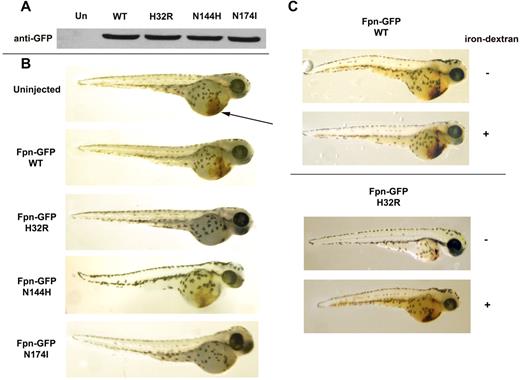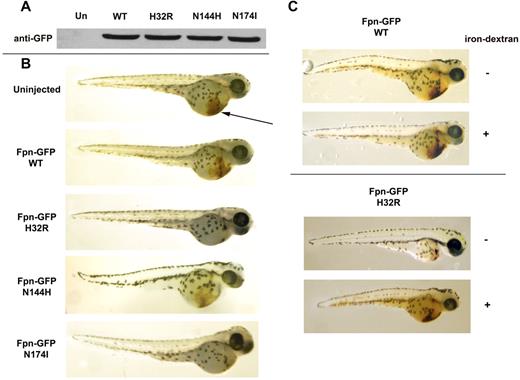On page 3781 of the 15 November 2007 issue, there is an error in Figure 1. The panel depicting Fpn-GFP N144H in Figure 1B was inadvertently duplicated from another panel in the original published figure. The authors have replaced the panel with the correct image. The findings of the paper have not been affected by the error. The authors apologize to the editors and readers for this mistake. The corrected figure is shown.
Expression of mutant Fpn in zebrafish affects hemoglobinization of erythrocytes. Zebrafish embryos were injected with wild-type or mutant Fpn-GFP. At 48 hpf, the embryos were homogenized (A), and Fpn-GFP levels were assayed by Western blot analysis or (B) stained with o-dianisidine to detect hemoglobinized cells (brown color denoted by the arrow). The figures are representative of 6 different experiments in which 100 embryos were injected with each construct. The survival rate (n = 600) was 69.6% for embryos injected with wild-type constructs, 50.8% for embryos injected with H32R constructs, 64.7% for embryos injected with N144H constructs, and 48.2% for embryos injected with N174I constructs. (C) Embryos were injected with wild-type or H32R constructs with or without coinjection of iron-dextran. The survival rate was 70% for wild-type embryos injected with or without iron-dextran, 50% for wild-type embryos injected with H32R without iron-dextran, and 62% for wild-type embryos injected with iron-dextran.
Expression of mutant Fpn in zebrafish affects hemoglobinization of erythrocytes. Zebrafish embryos were injected with wild-type or mutant Fpn-GFP. At 48 hpf, the embryos were homogenized (A), and Fpn-GFP levels were assayed by Western blot analysis or (B) stained with o-dianisidine to detect hemoglobinized cells (brown color denoted by the arrow). The figures are representative of 6 different experiments in which 100 embryos were injected with each construct. The survival rate (n = 600) was 69.6% for embryos injected with wild-type constructs, 50.8% for embryos injected with H32R constructs, 64.7% for embryos injected with N144H constructs, and 48.2% for embryos injected with N174I constructs. (C) Embryos were injected with wild-type or H32R constructs with or without coinjection of iron-dextran. The survival rate was 70% for wild-type embryos injected with or without iron-dextran, 50% for wild-type embryos injected with H32R without iron-dextran, and 62% for wild-type embryos injected with iron-dextran.



